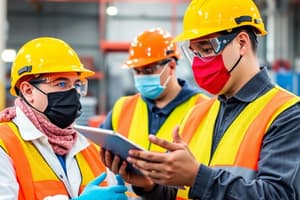Podcast
Questions and Answers
Which one of these conditions does not present a potential eye hazard recognized by OSHA? (Select all that apply)
Which one of these conditions does not present a potential eye hazard recognized by OSHA? (Select all that apply)
- Harsh lighting from industrial lamps (correct)
- Molten metals
- Toxic gases, vapors, and liquids
- Dusts, powders, fumes, and mists
What is the main purpose of a respirator?
What is the main purpose of a respirator?
To keep air contaminants out of a person's respiratory system.
Which one of these workplace conditions does not require employers to provide foot protection to their employees? (Select all that apply)
Which one of these workplace conditions does not require employers to provide foot protection to their employees? (Select all that apply)
- Loose terrain that might cause slipping (correct)
- Heavy machinery operation
- Wet surfaces
- Oil spills
Which one of the following potential hazards to feet is most uncommon in the workplace?
Which one of the following potential hazards to feet is most uncommon in the workplace?
What does research show about hearing loss?
What does research show about hearing loss?
If his employer is OSHA-compliant, Willard should be able to reach an eyewash station in _____ seconds.
If his employer is OSHA-compliant, Willard should be able to reach an eyewash station in _____ seconds.
When conducting a required assessment of the various hazards that may be present, an employer would consider all of the following except:
When conducting a required assessment of the various hazards that may be present, an employer would consider all of the following except:
Face shields do not protect the face from _____.
Face shields do not protect the face from _____.
It is estimated that the number of disabling accidents on the job involve the _____
It is estimated that the number of disabling accidents on the job involve the _____
It is necessary for employers to provide personal protective equipment to employees if any of these conditions exist except:
It is necessary for employers to provide personal protective equipment to employees if any of these conditions exist except:
Flashcards
Harsh lighting from industrial lamps
Harsh lighting from industrial lamps
OSHA does not recognize harsh lighting from industrial lamps as a potential eye hazard.
What is the main purpose of a respirator?
What is the main purpose of a respirator?
The primary function of a respirator is to prevent air contaminants from entering the respiratory system.
Loose terrain that might cause slipping
Loose terrain that might cause slipping
Employers are not obligated to provide foot protection for employees working on loose terrain that could cause slipping.
What is the most uncommon foot hazard in the workplace?
What is the most uncommon foot hazard in the workplace?
Signup and view all the flashcards
What does research show about workplace noise and hearing loss?
What does research show about workplace noise and hearing loss?
Signup and view all the flashcards
How quickly should an employee be able to reach an eyewash station?
How quickly should an employee be able to reach an eyewash station?
Signup and view all the flashcards
What is excluded from a hazard assessment?
What is excluded from a hazard assessment?
Signup and view all the flashcards
What does a face shield not protect against?
What does a face shield not protect against?
Signup and view all the flashcards
Which body part is most frequently involved in disabling accidents?
Which body part is most frequently involved in disabling accidents?
Signup and view all the flashcards
When are employers not required to provide personal protective equipment?
When are employers not required to provide personal protective equipment?
Signup and view all the flashcards
Study Notes
Eye Hazards
- Eye hazards recognized by OSHA include toxic gases, vapors, liquids, dusts, powders, fumes, mists, and molten metals.
- Harsh lighting from industrial lamps is not considered an eye hazard.
Respirators
- The primary function of a respirator is to prevent air contaminants from entering the respiratory system.
Foot Protection
- Employers are not required to provide foot protection for conditions like loose terrain that could cause slipping.
Uncommon Foot Hazards
- Frostbite is the least common potential foot hazard encountered in the workplace compared to compression, impact injuries, and electrical shocks.
Hearing Loss
- Hearing loss is gradual and often permanent, highlighting the importance of protective measures.
Eyewash Station Accessibility
- In cases of acid splashes, OSHA regulations require that employees reach an eyewash station within 10 seconds.
Hazard Assessments
- Employers must assess various hazards, including sources of motion, temperature extremes, and electrical hazards. Sources of mental stress do not fall under this requirement.
Face Shields Limitations
- Face shields do not provide protection against impacts, emphasizing the need for proper equipment for different hazards.
Disabling Accidents
- It is estimated that a significant number of disabling workplace accidents involve the hands, underlining the necessity for hand protection.
PPE Requirements
- Employers are obligated to provide personal protective equipment (PPE) when:
- Hazards are present or likely.
- Employees may come into contact with hazards during work.
- Employers cannot eliminate hazards in the workplace.
- The option "None of the above" indicates that all listed scenarios necessitate PPE provision.
Studying That Suits You
Use AI to generate personalized quizzes and flashcards to suit your learning preferences.




